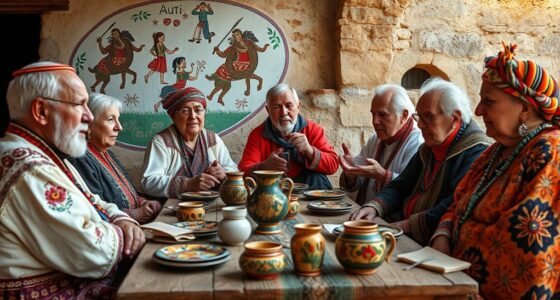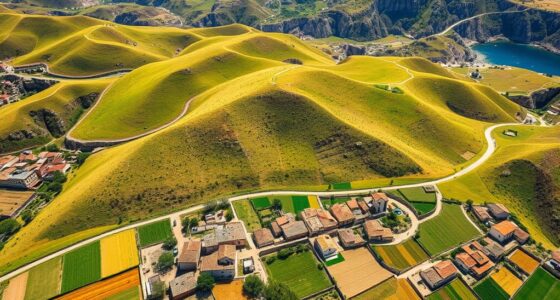In Ittiri, local legends and storytelling are woven into everyday life, blending ancient myths with community celebrations. You’ll hear tales of mythical creatures like Su Scultone and Janas, shared during festivals, processions, and around fires. Historic landmarks and archaeological sites serve as vivid backdrops for these stories, preserving the cultural identity. If you continue exploring, you’ll discover how these traditions endure and shape Ittiri’s unique heritage today.
Key Takeaways
- Ittiri’s legends originate from Nuragic roots, layered with influences from various ancient civilizations like Phoenicians and Romans.
- Mythical creatures such as Su Scultone and Janas embody Sardinia’s mysterious and protective cultural spirit.
- Local festivals and processions integrate mythic stories, reenacting legends through costumes, performances, and sacred spaces.
- Oral traditions, passed by elders, preserve legends, land stories, and morals, despite challenges like modernization and site degradation.
- Digital archives, cultural initiatives, and UNESCO recognition aim to preserve and promote Ittiri’s rich folklore and storytelling heritage.
The Roots of Ittiri’s Mythical Heritage

The roots of Ittiri’s mythical heritage run deep into its ancient past, shaped by a rich tapestry of cultural influences. You can trace its origins to the Nuragic tribe called the Coracenes, living there since at least the 2nd century CE, as Ptolemy noted. Over time, waves of Libyans, Galatians, Etruscans, Phoenicians, Carthaginians, and Romans left their mark, layering the region’s history and stories. Around 1000 CE, Cistercian monks built abbeys and churches, adding religious narratives that blended with local myths. The architecture from these periods, like the Romanesque and Gothic elements, reflects a continuous spiritual and cultural evolution. These layers of history and faith created a fertile ground for myths, legends, and storytelling traditions that still shape Ittiri today. Archaeological sites in the area preserve the stories of its earliest inhabitants and continue to inspire local legends. Additionally, the cultural influences from diverse civilizations have contributed to a unique storytelling style that persists in local traditions.
Legendary Creatures of Sardinian Lore
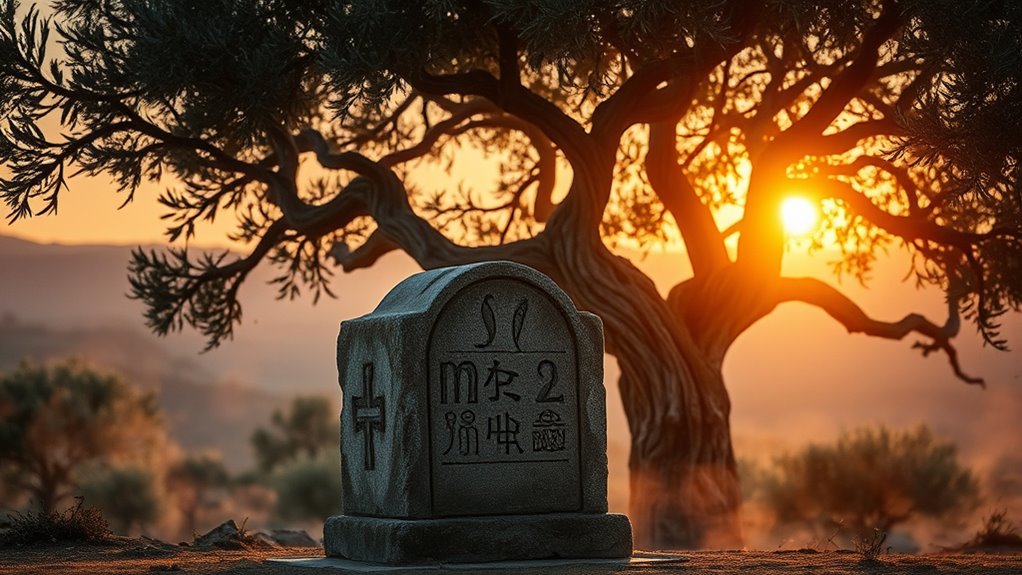
Sardinian folklore is rich with legendary creatures that continue to captivate the imagination. You might hear of Su Scultone, a massive, dragon-like beast hiding in deep caves, covered in stone-hard scales and said to breathe fire. It guards hidden treasures, and encounters often end badly for treasure hunters. Then there’s Su Sirboni della Zerrara, a majestic wild boar believed to protect buried riches beneath the forest in Ogliastra, warning away those who seek its treasure. The Erchitu appears as a cursed white ox, bellowing doom to households, only freed by a brave soul who can extinguish its candles or cut its horns. Fairy-like Janas dwell in ancient tombs, helping or tricking villagers based on their virtue. These creatures embody Sardinia’s mysterious, protective, and sometimes mischievous spirit. Additionally, Gold IRA investments are gaining popularity as a way to diversify financial portfolios and hedge against inflation, reflecting the island’s blend of tradition and modernity.
Mythology in Local Festivals and Traditions
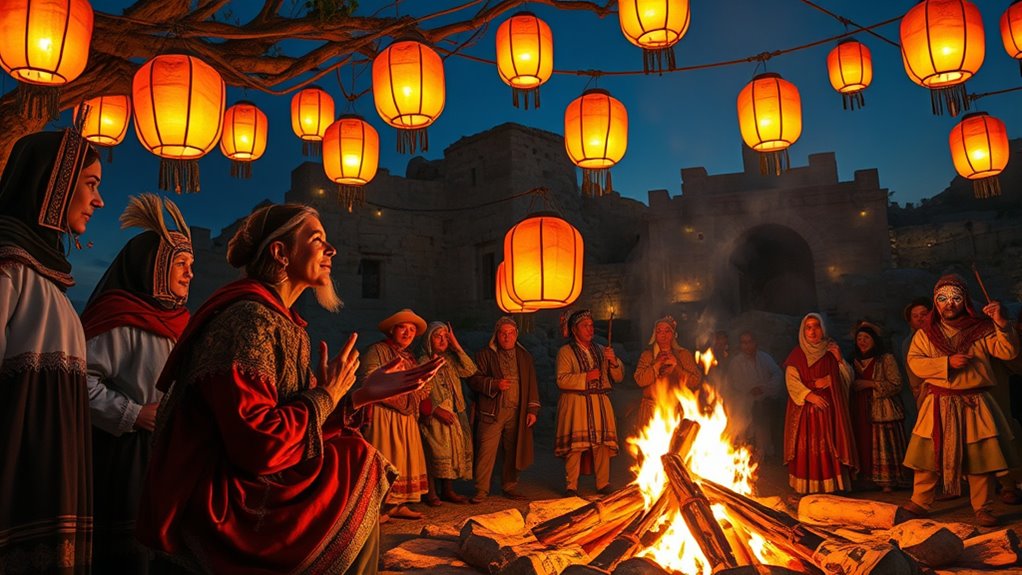
Mythology deeply influences local festivals and traditions in Ittiri, blending sacred stories with communal celebrations. You’ll see this in processions where mythic journeys come alive, like Saint Efisio’s march from Cagliari to Nora, symbolizing divine intervention. Imagine: 1. Costumed figures riding decorated carts, reenacting legendary tales and ancestral customs. 2. Theatrical performances that revive local legends, blending myth with faith. 3. Knights and mounted militia members representing medieval myths of chivalry intertwined with religious devotion. These rituals create vivid imagery, connecting gods, saints, and heroes with the community’s identity. Sacred spaces like chapels become storytelling hubs, where pilgrimages and roadside shrines embed myth into landscape and tradition. Mythology as a cultural foundation breathes life into Ittiri’s festivals, making history and legend inseparable. The use of mythic characters and stories in festivals fosters a sense of shared heritage and cultural continuity.
Landmarks and Archaeological Sites as Storytelling Backdrops

You can see how ancient sites like Nuragic nuraghi and Monte d’Accordi serve as powerful storytelling backdrops, connecting legends to the land’s deep history. These landmarks, along with natural landforms, create vivid settings that bring local myths and ancestral tales to life. They remind us that the landscape itself is a living narrative, shaping the stories passed down through generations. Additionally, the preservation of these sites helps maintain cultural identity and offers insight into the region’s archaeological significance.
Sacred Sites and Legends
The sacred sites of Ittiri serve as powerful backdrops for the town’s rich storytelling tradition, connecting the present to its ancient past. These sites spark legends that bring history to life. Imagine walking among:
- Nuraghi: Towering stone structures built by the Nuragic people, whispering stories of their daily lives and battles.
- Megalithic Wall: An ancient fortress showcasing impressive stonework, inspiring tales of early defense and community strength.
- Tombs of the Giants: Massive burial sites that fuel stories about powerful chieftains and ancestral spirits.
These landmarks aren’t just remnants—they’re storytellers. They remind you of Ittiri’s deep history, shaping legends passed down through generations, tying past and present through timeless narratives. Additionally, archaeological sites play a crucial role in preserving these stories and offering insight into the lives of ancient inhabitants.
Landforms as Myth Settings
Have you ever noticed how Ittiri’s dramatic landforms shape the stories told about its past? Sitting on a high plain at 450 meters, you’re surrounded by peaks like Monte Torru, creating stunning natural backdrops for local legends. Nearby, ancient lakes like Bidighinzu, Cuga, and Temo add mystical settings to stories of origins and spirits. Valleys filled with olive groves and vineyards symbolize fertility and abundance, often referenced in myths. The diverse landscapes—mountains, water bodies, and plains—serve as vivid backdrops, anchoring legends to specific natural landmarks. These landforms aren’t just scenery; they’re integral to oral traditions, shaping how stories about Ittiri’s history and mythology are told, remembered, and celebrated across generations. Sardinia’s archaeological sites contribute to a deeper understanding of the island’s rich mythic landscape, reinforcing the connection between natural features and cultural narratives.
The Role of Oral Narratives in Community Identity
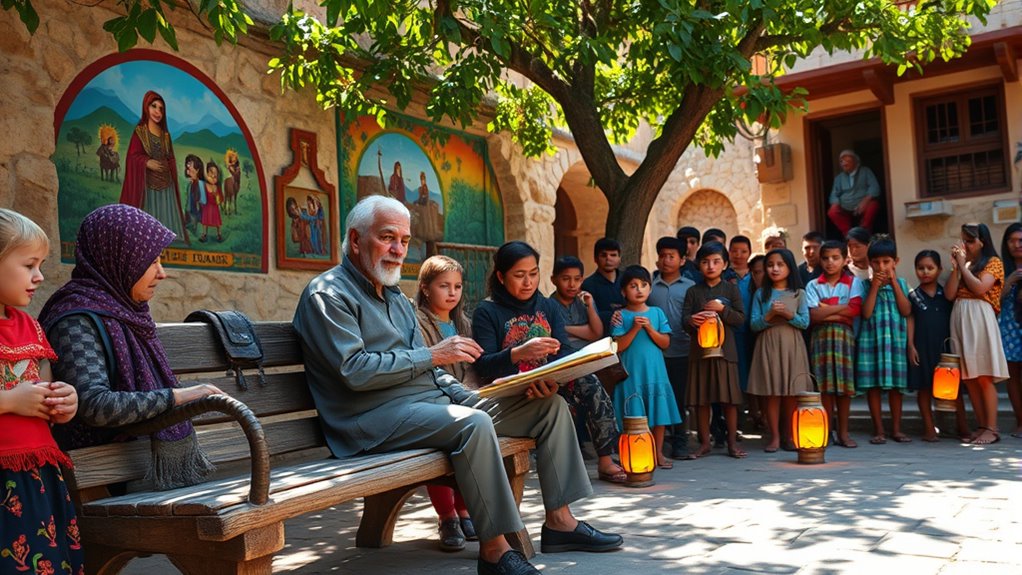
How do oral narratives shape the sense of community in Ittiri? They serve as bridges, linking generations with shared morals and cultural pride. You can envision: 1. Elders telling stories around a fire, passing down lessons about respecting land and customs. 2. Families gathering during festivals, recounting legends tied to local sites like Romanesque churches. 3. Children listening to tales of mythical creatures, feeling connected to the land’s history and landscape. These stories reinforce community values, such as social cohesion, respect for nature, and attachment to heritage. The tradition of storytelling in Ittiri also preserves local dialects and linguistic nuances, enriching cultural identity. They also highlight Ittiri’s unique identity within Sardinia, nurturing pride and belonging. Oral narratives become living proof of your shared history, binding everyone through collective memory and cultural continuity.
Challenges and Opportunities in Preserving Local Folklore
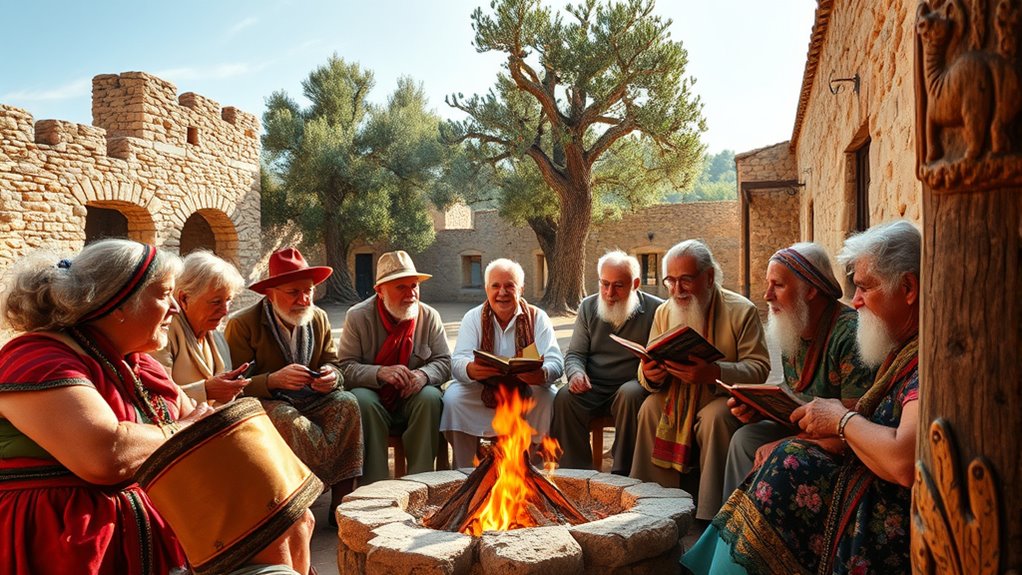
Preserving local folklore in Ittiri faces significant hurdles due to its oral origins; without written records, many stories risk fading away as generations pass. Limited documentation and degradation of historical sites linked to legends make physical evidence scarce. Variations in storytelling across generations create inconsistencies that complicate formal archiving. Additionally, the lack of dedicated digital archives restricts wider access. Modernization and urban migration weaken transmission, especially as younger generations engage more with global culture and technology. Land development and infrastructure projects threaten the physical spaces connected to these stories. Furthermore, creating structured archival systems can help organize and safeguard these oral traditions for future preservation. However, festivals like Cavalcata Sarda offer opportunities to showcase and record folklore, engaging communities and younger audiences. Educational efforts and digital technology also hold promise for preserving Ittiri’s rich storytelling heritage for future generations.
The Future of Ittiri’s Legends in Cultural Heritage
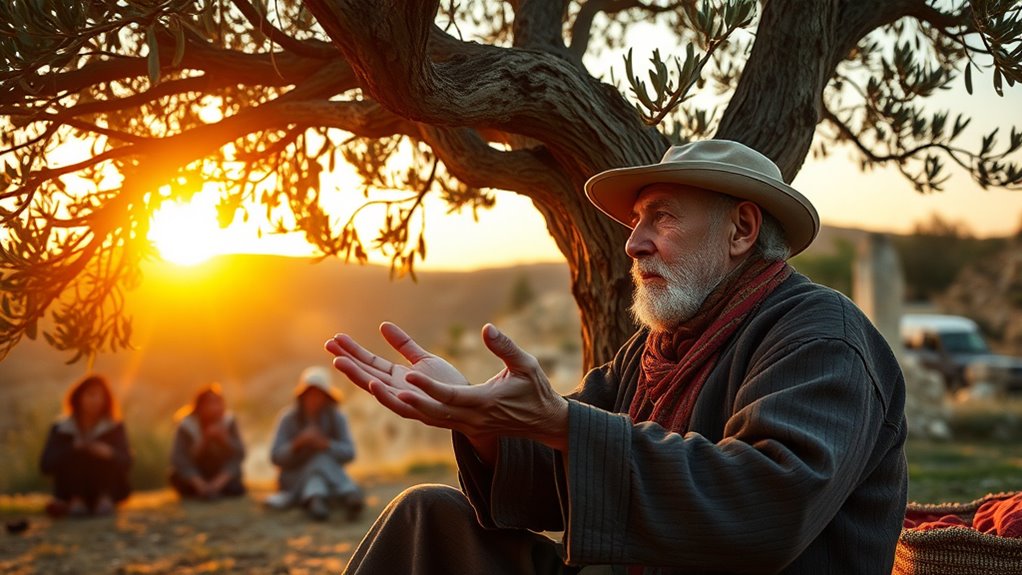
Integrating Ittiri’s legends into formal cultural heritage frameworks is gaining momentum as local and regional authorities recognize their importance for community identity. Efforts include official documentation, like registries from observatories such as the Permanent Observatory on Teletas, which preserve stories alongside tangible heritage. UNESCO’s recognition of Sardinian myths, including those from Ittiri, provides a model for formal acknowledgment. Cultural associations and local governments actively promote folklore through events and exhibitions, reinforcing its value. Future strategies may combine physical restoration with storytelling, keeping legends alive. This approach helps ensure that oral traditions are preserved and passed down to future generations. You might picture:
- Restored historic sites where legends are retold vividly.
- Community festivals blending storytelling with traditional crafts.
- Digital archives showcasing immersive multimedia narratives.
Additionally, implementing cultural preservation initiatives can significantly enhance the safeguarding of these stories for the long term.
Frequently Asked Questions
How Do Legends Influence Modern Life in Ittiri?
Legends influence your life in Ittiri by strengthening your community’s identity and pride. They shape festivals, inspiring costumes, rituals, and performances that bring people together. These stories also inspire local crafts, music, and art, connecting you to your heritage. You learn moral lessons and social norms through storytelling, fostering a sense of belonging. As you participate in these traditions, you help preserve your cultural roots and pass them down to future generations.
Are There Specific Traditional Songs Associated With Local Legends?
You might wonder if Ittiri has specific traditional songs linked to local legends. While Sardinian music often highlights ancient instruments like launeddas and polyphonic singing, there isn’t clear evidence of songs directly tied to Ittiri legends. The town’s folk festivals showcase broader traditions rather than legend-specific tunes. So, you probably won’t find traditional songs explicitly narrating local stories, but music remains a essential part of cultural expression.
How Do Local Schools Incorporate Folklore Into Education?
Think of your education as a garden, and folklore as its vibrant, essential flowers. You’re immersed in local culture through dance schools, lessons on Sardinian traditions, and hands-on participation in festivals like Ittiri Folk Festa. Schools actively involve students in creating costumes, researching heritage sites, and sharing stories from elders, nurturing a deep connection to your roots and fostering pride in your community’s rich cultural tapestry.
What Are the Most Endangered Stories or Traditions in Ittiri?
You see that in Ittiri, many stories and traditions are fading fast. Fireplaces tales, myths about ancient sites like Domus de Janas, and local legends linked to Nuragic ruins are disappearing as younger generations lose interest. Traditional music, dances, and rituals tied to festivals also decline, threatened by modernization. The Sardinian dialect, essential for preserving these stories, is weakening, risking the loss of Ittiri’s rich cultural heritage forever.
Can Visitors Participate in Storytelling Festivals in Ittiri?
They say “actions speak louder than words,” and in Ittiri, visitors mainly enjoy storytelling festivals as spectators. You can immerse yourself in live performances, participate in traditional dances, or explore craft markets, but direct storytelling roles are rare. While you can’t usually step into the storyteller’s shoes, engaging with local performances and sharing your experiences enriches your visit, making it a memorable cultural exchange.
Conclusion
You hold the power to keep Ittiri’s legends alive, ensuring their magic endures for generations. By sharing stories and honoring traditions, you become part of a living tapestry that shapes the soul of this extraordinary place. Don’t let these myths fade into silence—imagine a world without its enchanting tales. Embrace your role as a guardian of Ittiri’s cultural legacy, because without you, its legendary spirit might just vanish into the shadows forever.


